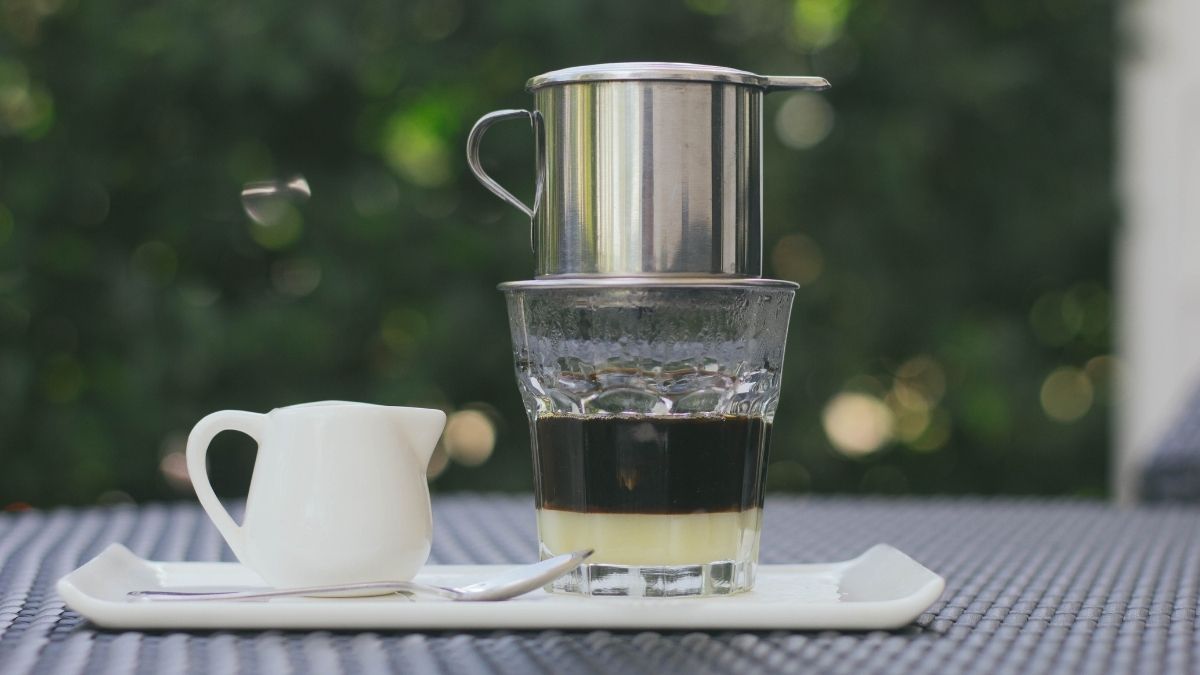Vietnam is now the world’s largest supplier of Robusta coffee beans, as well as the world’s second-largest exporter. Vietnam’s coffee culture is so diverse because the Vietnamese adore and cherish their coffee too much that they create unique coffee-based cocktails that people can’t get elsewhere. Is Vietnamese coffee, on the other hand, stronger?
Yes, Vietnamese coffee is definitely stronger than most other forms of coffee. This is due to the characteristics of coffee beans being used in Vietnamese traditional coffee and the method by which Vietnamese coffee is prepared.
What makes Vietnamese coffee strong and unique? Continue reading to get the answers to all these questions.
Vietnamese Coffee Culture
In 1850, the French established the coffee business and customs in Vietnam by growing the first Arabica plants. Many years later, Robusta and Liberica were cultivated.
Nowadays, Robusta has been the most popular variety of coffee grown in Vietnam, and it’s what you’d find at coffee shops and restaurants.
Only four decades ago, Vietnam produced 300,000 sacks of coffee each year. In 1986, they abandoned its ‘Doi Moi’ economic platform in favor of a business economy.
As an outcome, output has increased by over 30 million sacks every year. There is even a surge in the number of Vietnamese independent coffee shops.
What Makes Vietnamese Coffee Strong?
The intensity of a blonde brewed espresso may vary depending on a number of parameters, including roasting period, coffee ground size, volume, and brewing process.
Obviously, the primary provider of caffeine is the coffee bean type itself, however, the temperature level of the brewing water also influences the quantity of coffee extracted. Let’s take a closer look at some of these factors.
Robusta Coffee Beans
Vietnamese coffee is prepared using Robusta coffee beans that are less delicate than Arabica and grow three times as tall.
Robusta has limited natural carbohydrates and fats. This gives the coffee a stronger chocolaty flavor. They also contain 2.7 percent caffeine, which is nearly double that of Arabica, resulting in a somewhat more intense flavor.
Grind Size
In making Vietnamese coffee, freshly ground coffee is commonly consumed. The finer grinding helps to manage the rate of flow and guarantees that the liquid does not just trickle down, as can happen with such a coarser grind.
The finer the grind, the more surface area is visible, which improves caffeine absorption.
Brewing Method
Vietnamese coffee demands a longer brewing time, resulting in a stronger caffeine dose. It’s produced with phin, which is the Vietnamese equivalent of the coffee drip without the need for a paper filter.
It is made out of a brewing container, a metal filter, a tamp to compress the grinds firmly, as well as a lid to keep the temperature in.
Dark Roast
Vietnamese coffee is usually produced with a dark roast. However, rather than employing a greater heat, Vietnamese coffee is being roasted for a longer period of time.
The technique ensures a uniform roast and avoids the dissolution or oxidizing of the sugars and lipids. It has no effect on caffeine levels and contributes to the coffee’s distinctive dark color and powerful taste.
Local Palate
Vietnamese food is delicious and bright, with plenty of garlic, fish sauce, and fresh basil. The native taste has been used to bold taste qualities.
Coffee is one of the inhabitants’ regular routines, a power grab before going to work. You’ll never really see people drinking that on the move; instead, they’ll take a seat and savor it peacefully.
Caffeine Content Of Vietnamese Coffee
It is mentioned earlier that Robusta coffee contains more caffeine compared to Arabica. Let’s see how that compares inside a cup. A 6-ounce mug of Robusta contains about 200 mg of caffeine, whereas a 6-ounce mug of Arabica contains 130 mg. The FDA recommends 400 mg of caffeine each day, so this equates to no over than 2 mugs of Vietnamese coffee a day.
Undoubtedly, Arabica beans can now be used to make Vietnamese cups of coffee. When you’re worried over your caffeine dosage, you may still gently inquire more about the kinds of coffee beans used by the barista.
Vietnamese Coffee Preparation
A stainless steel coffee drip filter is used to make Vietnamese traditional coffee. You fill its filter with the appropriate quantity of grinds then set it across the cup or mug which you will sip from. Fill the filter halfway with hot water and allow it to bloom for another few seconds in order for the coffee grounds to enlarge. To make a much more delicious brew, press the coffee in the filters prior to actually pouring the excess water.
You can also use a French press if you have one. But, using a normal coffee machine for Vietnamese coffee is never advised. The idea is to maintain it all as raw and natural as possible. Serve ice cold or hot. Condensed milk has been the sole sweetener being used in iced or hot Vietnamese coffee. It provides just a bit of sweetness and creaminess without overpowering coffee’s taste.
The Taste Of Vietnamese Coffee
Vietnamese coffee has always had an extremely powerful and harsh flavor profile because it is a deeper roast. As previously stated, condensed milk was typically used to sweeten and soften coffee rather than standard cream, milk, and sugar.
Also, it contains more acid compared to your normal coffee, which contributes to the taste distinction.
Because of the intense flavor and heaviness of a drip, most folks prefer to consume it cooled instead of hot. Trying to pour it all over ice plus condensed milk smoothes the drink and makes it a lot easier to drink.
Because many Americans prefer the milder taste of Arabica beans, Robusta coffee isn’t quite as popular in the United States. Vietnam could, however, grow Arabica beans, though they are not as famous as that of the Robusta kind.
It is fairly popular to drink Vietnamese coffee with such a rich and dark roast.
Vietnamese Coffee Brands Options
There are many other varieties of Vietnamese coffee available. When you’re eager to give it a chance, here are some of the finest brands available at the moment.
Trung Nguyen
The taste of this product is quite rich and powerful. The coffee beans are indeed a quality combination of Robusta and Arabica with just a little chocolate undertone. When prepared, it emits a lovely scent that is both fresh and strong. Because the coffee beans were cultivated in elevated soil, they have a pleasant taste that all coffee enthusiasts will like.
Chestbrew Moonbear
Chestbrew’s Moonbear blend is composed entirely of Arabica coffee beans. It really is powerful and natural, without any fillers. This company claims that its high-quality Vietnamese coffee would be not only genuine but also ideal for such a delicious cold brew. This also lacks the aftertaste of traditional Vietnamese coffee, however, that doesn’t imply it’s lacking in assertiveness.
Saigon Phin Daklak
This coffee is produced by a family-owned enterprise in Tay Nguyen, Vietnam. The manufacturing plant is located in Saigon. Despite being a mixture, this coffee is designed for Vietnamese traditional iced coffee, often referred to as Cafe Sua Da. Arabica, Robusta, Peaberry, Arabica, and soybean are used in the combination. For such optimal outcomes, brew it with a conventional sieve or use a French press.
Cafe Du Monde
You’re likely asking why, since we’re dealing with Vietnamese coffee, this product has such a French name. Vietnam was a French protectorate from the late 1800s to the 1950s, and their people thoroughly liked the tastes of the Cafe Du Monde ground coffee. It is dark roasted that has been combined using chicory root to provide a rich and vibrant taste.
Dalat Peaberry Robusta
This product has a strong taste quality, with thick and luscious chocolate undertones. It is a mid-roasted coffee designed for those who want their coffee robust. The Dalat Peaberry Robusta’s silky body produces its excellent use in Italian mixed coffees. The strong caffeine level and mild acidity contribute to its softness.
Is It Safe To Drink Vietnamese Coffee?
Yes, Vietnamese coffee would be safe for consumption, but just be attentive to the period of the day you consume it. Many individuals live for Vietnamese coffee and consume it on a daily basis. This is just really strong, which might be difficult for beginner coffee drinkers to take. Because it contains twice as much caffeine content compared to Arabica beans and North American coffee, it may be difficult to catch asleep after just a full cup.
Coffee Verdict
Vietnamese traditional coffee is quite powerful! On any given day, a cup of this brewed coffee outperforms any cup of black coffee.
Vietnamese coffee is ideal for an early fill, an after-lunch pop, or perhaps even teenagers doing all-nighters prior to the exam day.
If you consume Vietnamese coffee at the wrong time of the day, you can end up spending up all night being awake. That’s how strong this coffee is.
Don’t forget to drink your coffee in moderation, coffee lovers!

